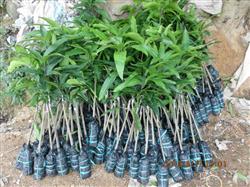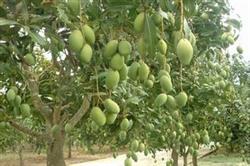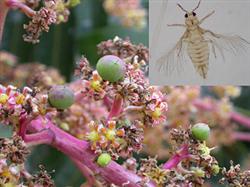Cultivation techniques of Ganoderma lucidum with mango sawdust

Ganoderma lucidum is the treasure of traditional Chinese medicine, known as Ganoderma lucidum, Ruicao, is the general name of all fungi of the genus Ganoderma of Ganoderma lucidum. In the natural state, the rotten wood of broad-leaved trees is saprophytic growth. Ganoderma lucidum can be collected all over the country, but due to excessive deforestation of forest vegetation, more and more wild species have become increasingly rare and poor. Wild distribution of Ganoderma lucidum can be seen in Zhuhai, mainly growing on dead trees such as Acacia and Melia azedarach. The substitute cultivation of Ganoderma lucidum is usually made of scraps of trees or agricultural by-products and an appropriate amount of excipients. Due to typhoon prevention and other reasons, Zhuhai has to trim a large number of street greening tree species every year. Mango, as a native tree species in Zhuhai, is mostly selected as street greening trees. How to make full use of wood waste and turn waste into treasure, the author uses mango as the main wood raw material of Ganoderma lucidum cultivation substrate, adding cottonseed hull, wheat bran and other auxiliary materials to grow Ganoderma lucidum by substitute cultivation method. in order to determine the formula of substitute cultivation medium with Zhuhai characteristics. 1 Materials and methods 1.1.The research experiment of this project is located at Meixi Base of Zhuhai Agricultural Science Research Center, located in the south of Guangdong Province, with a south subtropical monsoon climate, sufficient sunshine, an annual average temperature of 22.4 ℃ and an annual average relative humidity of 79%, which is suitable for the annual cultivation of Ganoderma lucidum. 1.2 Experimental material 1.2.1 the raw material of sawdust is mango wood, a landscaping tree species widely planted in Zhuhai, with a side branch diameter of more than 4 cm. The wood was cut at Meixi Base of Zhuhai Agricultural Science Research Center in May and June 2009 and crushed into sawdust particles with a diameter of ≤ 5 mm. 1.2.2 the tested strains were Ganoderma lucidum strains provided by the strain Experimental Center of Huazhong Agricultural University. 1.3.1Maternal culture medium PDA (1000 mL): potato 200g, glucose 20g, peptone 1g, potassium dihydrogen phosphate 1g, Agar powder 15g, adding water to 1000mL. 1.3.2 original medium mango sawdust 73%, wheat bran 25%, calcium sulfate 2%. 1.3.3 according to the quality ratio, the contents of mango sawdust, cottonseed hull and wheat bran were 39.5%, 39.5%, 20% and 59%, 20%, 20%, 69%, 10%, 20%, 69%, 10%, 10%, 79%, 10%, 10%, 79%, 10%, 10%, 79%, 10%, 10%, 79%, 10%, 10%, 79%, 10%, 10%, 79%, 10%, 10%, 79%, 10%, 10%, 79%, 10%, 10%, 79%, 10%, 10%, 79%, 10%, 10%, 79%, 10%, 10%, 79%, 10%, 10%, 79%, 10%, 10%, 79%, 10%, 10%, 79%, 10%, 10% Deal with 6pr 89%, 0%, 10%. Each medium is supplemented with 1% calcium sulfate and 60% water content of the medium. 1.3.4 cultivation management and statistics cultivation package was packed with polypropylene plastics with specifications of 17 cm × 30 cm (11230,-55.00,-0.49%) in bags for 1 kg wet replanting culture material, and steam sterilization was carried out at 121 ℃, 0.15 MPa for 2.5 h. After cooling, the bacteria were inoculated in a double-headed manner. After inoculation, the bacteria were sealed and stacked neatly. After the mycelium is full, it is transferred to the sesame room to manage the opening of the bag. The experiment was carried out from July to September with an average temperature of 29.1 ℃. 10 bags were randomly selected for fixed-point observation, and the mycelium growth rate, growth, budding time, fruiting body size and shape were recorded. Ganoderma lucidum was harvested and dried and the dry mass was measured. 2 results and analysis 2.1 effects of different media on mycelium growth of Ganoderma lucidum from Table 1, there were significant differences in mycelium growth, growth rate, full bag time and budding time in different media. Treatment 6 grew the fastest, the mycelium grew weakest, and the full bag time was the shortest, but the budding time was the longest. The mycelium growth of treatment 5 and 3 was faster and the full bag time was shorter, the mycelium growth of treatment 3 was better and the budding time was shorter than that of treatment 5, the mycelium growth of treatment 2 and 4 was slower and the budding time was shorter than that of treatment 4. Treatment 1 has the slowest mycelium germination rate, the slowest growth rate and the longest full bag time, but the mycelium growth is the best and the budding time is the shortest. These results show that the content of wheat bran plays a key role in mycelial growth and budding. When the content is 20%, the mycelium is dense and sturdy, the budding and opening time is short, when the content is 10%, the mycelium is sparse, and the budding time is longer; when the mango sawdust content is high, the mycelium germinates and grows faster, and the full bag time is shorter, but due to the large sawdust gap, the mycelium is sparse, non-fruiting, uneven and the budding time is delayed. 2.2 the effects of different media on the shape of fruiting body of Ganoderma lucidum can be seen from Table 2. Among the six treatments, the shape of fruiting body was divided into two categories. The cap of fruiting body of treatment 1, 2 and 3 was fan-shaped, the color was lighter and the stalk was flat cylindrical. The cap of fruiting body of treatment 4, 5 and 6 was oval to round, dark in color, slender and cylindrical in shape. There were significant differences in the length, width, thickness, stalk length and thickness of the cap. The length, width and stalk thickness of hyphae were treatment 1 > treatment 2 > treatment 3 > treatment 4 > treatment 5 > treatment 6; the length of stalk was treatment 6 > treatment 5 > treatment 4 > treatment 3 > treatment 2 > treatment 1; the thickness of cover is as follows: treatment 6 > treatment 5 > treatment 4 > treatment 1 > treatment 3 > treatment 2. The results showed that the content of wheat bran also played a key role in the cap morphology of fruiting body, which was consistent with the effect of wheat bran content on the budding time. When the content of wheat bran is high, due to the early opening time, wide cap, short and strong stalk, low content of wheat bran, the opening time is delayed, and the shape of fruiting body is more similar to that of wild Ganoderma lucidum. In addition, with the decrease of the ratio of mango sawdust to cottonseed shell, the cap became smaller. 2.3 effects of different media on yield and medicinal components of Ganoderma lucidum from Table 3, the yield and biological efficiency of Ganoderma lucidum fruiting body were positively correlated with its shape, that is, the dry weight of fruiting body, dry mass of spore powder and biological efficiency of treatment 1, 2 and 3 were higher, while the values of treatment 4, 5 and 6 were lower. However, there was no significant difference in the contents of Ganoderma lucidum polysaccharides, total triterpenes and germanium among the six treatments. In order to further explore the effect of different culture media on the yield of Ganoderma lucidum fruiting body, the analysis of variance and Duncan's new complex range test were carried out on the dry weight of fruiting body. The results are shown in tables 4 and 5. The results of variance analysis showed that different media had extremely significant effects on the yield of Ganoderma lucidum. The results of Duncan's new complex range test showed that there were extremely significant differences between treatments 1, 2, 3 and treatments 4, 5, 6, indicating that wheat bran content was the dominant factor in the yield of Ganoderma lucidum. There was no significant difference among treatments 1, 2 and 3, but there was no significant difference among treatments 4, 5 and 6. The yield of fruiting body decreased slightly with the increase of sawdust ratio. 3 conclusion and discussion 1) Mango sawdust is used as the main material for the cultivation of Ganoderma lucidum, the mass ratio is between 39.5% and 79%, which is suitable for the growth of Ganoderma lucidum. There is no significant difference in the active components of each treatment, the mycelium grows rapidly and the shape of fruiting body is normal. As the main raw material of substitute cultivation, the crushing quality of mango sawdust must be strictly controlled to achieve moderate size and uniform shape, so as to ensure the consistent quality of the bag. As a native tree species in Zhuhai, mango is mostly chosen as street greening tree. as far as the climatic conditions of Zhuhai are concerned, mango can promote new shoots in the four seasons, and the branches grow most vigorously in spring and summer. however, the exuberant crown brings problems for windbreak and emergency rescue in the typhoon season. therefore, Zhuhai has to trim a lot of mango wood every year. By using mango sawdust as the cultivation substrate of Ganoderma lucidum, the local wood waste can be more fully utilized, turn waste into treasure, save production cost and kill two birds with one stone. 2) when the addition of wheat bran in the culture medium reached 20%, the mycelium was strong and sturdy, the budding time was short, the fruiting body cap was wide, and the yield was high. This is related to the fact that as an auxiliary material with high nitrogen content, wheat bran can balance the ratio of carbon to nitrogen in the matrix. 3) in the main materials of the culture medium, mango sawdust and cottonseed shell are both components with high carbon content, and their nutritional functions are the same, but with the increase of the mass ratio of mango sawdust to cottonseed shell, the shape and yield of fruiting body decrease slightly, which is mainly related to the physical properties of cottonseed hull. It has good air permeability and strong plasticity, and can effectively fill the gap between mango sawdust, make the culture medium loose and tight, and the mycelium grow evenly. It is more beneficial to the growth of mycelium in the later stage and the budding time in advance. Therefore, it is suggested that on the basis of using mango sawdust as the main material for Ganoderma lucidum cultivation, cottonseed shell should be added as buffer material, and the composition should be 5%-10%. 4) the main and auxiliary materials commonly used in Ganoderma lucidum cultivation include: Acacia sawdust, cottonseed hull, corn (2349, 8.00,0.34%) flour, wheat bran, etc., which can only be obtained through procurement and logistics in Zhuhai, resulting in high production costs and seasonal restrictions on raw material supply. at present, the cost of formula raw materials widely used in Ganoderma lucidum planting industry is about 1400 yuan. Therefore, while selecting mango wood as the main material of the matrix, on the premise of ensuring the product quality, the addition amount of various foreign materials should be reduced as much as possible. It is suggested that the mango sawdust culture medium for Ganoderma lucidum cultivation in Zhuhai area is as follows: mango sawdust 69%, cottonseed hull 10%, wheat bran 20%, calcium sulfate 1%, medium water content 60%, mango sawdust crushed into particles with a diameter of ≤ 5 mm, and the cost of the formula is estimated to be 600 yuan.
- Prev

Irrigation and fertilization techniques of mango trees
For every 1000 kilograms of fresh mango, it takes 1.74 kilograms of NRU, 1.74 kilograms of P2O5:0.23, and one kilogram of K2O:2.0. Potassium is the most needed, followed by nitrogen and phosphorus. In production, nitrogen, phosphorus and potassium fertilizers are generally applied according to N:P2O5:K2O=1:0.5:0.5~1, but mangoes with different tree ages, different regions and different yield levels.
- Next

Control techniques of diseases and insect pests at flowering and panicle stage of mango
After the mango ear was damaged by diseases and insect pests, the flower ear was deformed, the flower quality decreased, the flower bud fell off, the flower withered, and could not blossom and bear fruit. The prevention and control methods of diseases and insect pests that harm the flower ear of mango are as follows: first, anthrax is the most serious disease that harms the flower ear, which occurs as soon as the flower ear is pulled out.
Related
- Moge, come on! The staff of the peasant association in the producing area of cantaloupe were frightened when the crowd gathered.
- Causes and Solutions of low Fruit setting rate of Apple
- Symptoms and control measures of passion fruit virus disease
- Fruit growing lesson: how do apple orchards keep high yields?
- Can you build orchards in the mountains? What are the pros and cons?
- How to manage the coloring period of Crisson grape?
- This paper introduces the processing technology of two kinds of fig products.
- How much is a month for retired teachers in rural areas by 2020?
- How can strawberry planting increase sugar content? We should pay attention to management in many aspects.
- What are the cultivation techniques on how to improve the yield of golden fruit?

